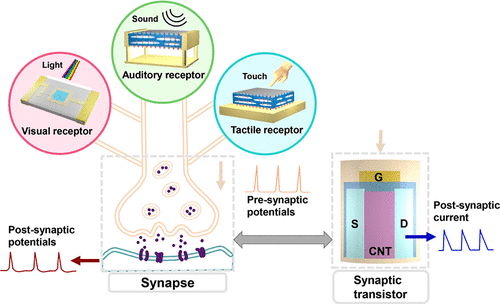Our official English website, www.x-mol.net, welcomes your
feedback! (Note: you will need to create a separate account there.)
Multimodal Artificial Neurological Sensory–Memory System Based on Flexible Carbon Nanotube Synaptic Transistor
ACS Nano ( IF 15.8 ) Pub Date : 2021-09-02 , DOI: 10.1021/acsnano.1c04298 Haochuan Wan , Junyi Zhao , Li-Wei Lo , Yunqi Cao 1 , Nelson Sepúlveda 2 , Chuan Wang
ACS Nano ( IF 15.8 ) Pub Date : 2021-09-02 , DOI: 10.1021/acsnano.1c04298 Haochuan Wan , Junyi Zhao , Li-Wei Lo , Yunqi Cao 1 , Nelson Sepúlveda 2 , Chuan Wang
Affiliation

|
As the initial stage in the formation of human intelligence, the sensory–memory system plays a critical role for human being to perceive, interact, and evolve with the environment. Electronic implementation of such biological sensory–memory system empowers the development of environment-interactive artificial intelligence (AI) that can learn and evolve with diversified external information, which could potentially broaden the application of the AI technology in the field of human–computer interaction. Here, we report a multimodal artificial sensory–memory system consisting of sensors for generating biomimetic visual, auditory, tactile inputs, and flexible carbon nanotube synaptic transistor that possesses synapse-like signal processing and memorizing behaviors. The transduction of physical signals into information-containing, presynaptic action potentials and the synaptic plasticity of the transistor in response to single and long-term action potential excitations have been systematically characterized. The bioreceptor-like sensing and synapse-like memorizing behaviors have also been demonstrated. On the basis of the memory and learning characteristics of the sensory–memory system, the well-known psychological model describing human memory, the “multistore memory” model, and the classical conditioning experiment that demonstrates the associative learning of brain, “Pavlov’s dog’s experiment”, have both been implemented electronically using actual physical input signals as the sources of the stimuli. The biomimetic intelligence demonstrated in this neurological sensory–memory system shows its potential in promoting the advancement in multimodal, user-environment interactive AI.
中文翻译:

基于柔性碳纳米管突触晶体管的多模态人工神经感觉记忆系统
作为人类智能形成的初始阶段,感觉记忆系统在人类感知环境、与环境交互和进化方面起着至关重要的作用。这种生物感官记忆系统的电子化实现了环境交互人工智能(AI)的发展,它可以随着多样化的外部信息学习和进化,这可能会拓宽人工智能技术在人机交互领域的应用。在这里,我们报告了一种多模式人工感觉记忆系统,该系统由用于产生仿生视觉、听觉、触觉输入的传感器和具有突触样信号处理和记忆行为的柔性碳纳米管突触晶体管组成。将物理信号转换成包含信息的,突触前动作电位和晶体管响应单次和长期动作电位激发的突触可塑性已被系统地表征。类似生物受体的传感和类似突触的记忆行为也已得到证实。基于感觉-记忆系统的记忆和学习特性,著名的描述人类记忆的心理模型,“多存储记忆”模型,以及展示大脑联想学习的经典条件反射实验,“巴甫洛夫的狗实验” ”,都使用实际的物理输入信号作为刺激源以电子方式实现。这种神经感觉记忆系统所展示的仿生智能显示了其在促进多模式发展方面的潜力,
更新日期:2021-09-28
中文翻译:

基于柔性碳纳米管突触晶体管的多模态人工神经感觉记忆系统
作为人类智能形成的初始阶段,感觉记忆系统在人类感知环境、与环境交互和进化方面起着至关重要的作用。这种生物感官记忆系统的电子化实现了环境交互人工智能(AI)的发展,它可以随着多样化的外部信息学习和进化,这可能会拓宽人工智能技术在人机交互领域的应用。在这里,我们报告了一种多模式人工感觉记忆系统,该系统由用于产生仿生视觉、听觉、触觉输入的传感器和具有突触样信号处理和记忆行为的柔性碳纳米管突触晶体管组成。将物理信号转换成包含信息的,突触前动作电位和晶体管响应单次和长期动作电位激发的突触可塑性已被系统地表征。类似生物受体的传感和类似突触的记忆行为也已得到证实。基于感觉-记忆系统的记忆和学习特性,著名的描述人类记忆的心理模型,“多存储记忆”模型,以及展示大脑联想学习的经典条件反射实验,“巴甫洛夫的狗实验” ”,都使用实际的物理输入信号作为刺激源以电子方式实现。这种神经感觉记忆系统所展示的仿生智能显示了其在促进多模式发展方面的潜力,











































 京公网安备 11010802027423号
京公网安备 11010802027423号